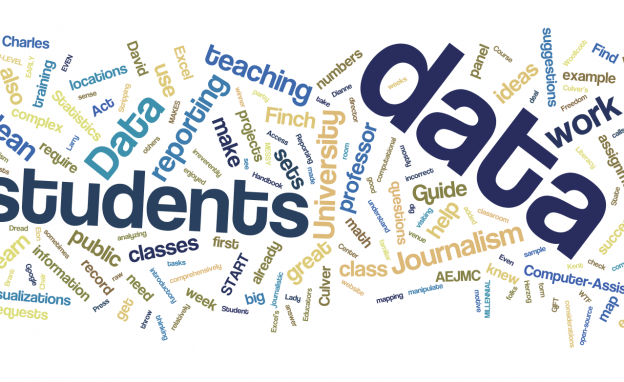As I begin to think about my spring classes, the big ideas that emerged from an AEJMC teaching panel on incorporating data into journalism classes continue to resonate.
The venue was a conference room at the Association for Educators in Journalism and Mass Communication annual convention in San Francisco in early August.
Since I built and taught Kent State’s first data reporting class in the fall of 2014, I knew there were folks out there more experienced in coaching and teaching this type of reporting. While I think our class was mostly a success — the students seemed to learn a lot and enjoyed the projects they worked on — I knew others would have great ideas and suggestions.
Our panel members were Steve Doig, the Knight Chair for Computer-Assisted Journalism at Arizona State University; Katy Culver, assistant professor and associate director of the Center for Journalism Ethics at the University of Wisconsin; Nick Geidner, an assistant professor at the University of Tennessee at Knoxville and the winner of the 2015 AEJMC GIFT competition; and Dianne Finch, a visiting assistant professor at Elon University.
All of the panelists made great suggestions — here are the ones I found most helpful.
1. START EARLY:
Include beginner-level data literacy and basic computational skills in your introductory news courses. Even if you’re not a math whiz yourself, you can get your students thinking about data in their early reporting classes with some simple exercises. Culver calls this her “gospel” and writes comprehensively about the concept here.
2. MAKE IT INTERESTING TO A MILLENNIAL:
Find assignments that are so interesting to your students they’ll forget they’re working with data. Find data sets that deal with things they’re already familiar with, rather than government numbers that seem obscure. Also, start them off with assignments that use relatively clean data sets so they have some success, then build to more difficult ones that may need more work to clean up or are more complex.
For example, Geidner’s students dig into the money tied to Lady Gaga’s foundation. Culver’s students map the locations of crimes on campus using Clery Act data. They also map the locations of off-campus house party busts.
3. START AT THE BEGINNING, EVEN IN AN UPPER-LEVEL CLASS:
Don’t presume your students know how to use Excel’s features to manipulate and clean data. Finch said it was her biggest surprise when she began teaching data classes, so she added a week of Excel training to the first week of her curriculum. Assigning video tutorials before class starts isn’t enough, Finch said in an email. “They require training in the classroom with specific tasks” because Excel is more complicated and powerful than the students realize.
4. MESSY DATA MAKES FOR MOST OF THE WORK:
About 85 percent of the work you’ll do with raw data is of the cleaning, analyzing, sifting and sorting variety. The more complex the data, the more work is needed to clean it and make it usable and understandable. It’s also the time when ethical considerations weigh in the most.
What questions do you ask of your data? What information do you keep, and what do you throw out? Which “outliers” are actually newsworthy? Where did the data come from, who collected it and do they have an ulterior motive in doing so? The journalistic questions are the most important to answer with the numbers. It’s not about the numbers themselves but the stories they tell.
Some of the instructors “hide” some outrageously out-of-whack figures in sample data they give their students to see if they find it and question it. They also sometimes include incorrect calculations, to be sure their students check the math themselves.
5. PUBLIC RECORDS:
Many successful data projects require the use of public records, so you’ll need to help your students learn how to make public record or Freedom of Information Act requests. Keep in mind it can take months to get the information, so you may want to have some data sets already available for them to work on.
There are lots of great resources to help you learn to teach data skills in your own classrooms. Some of those mentioned include:
- “Naked Statistics: Stripping the Dread from the Data,” by Charles Wheelan
- Making Sense of Data (The Google Data Course)
- WTF Visualizations – Visualizations that make no sense, to help your students understand what doesn’t work
- “Data Literacy: A User’s Guide,” by David L. Herzog
- The Investigative Reporters and Editors website
- “Computer-Assisted Reporting: A Practical Guide,” by Brant Houston
- “The Art of Access: Strategies for Acquiring Public Records,” by David Cullier and Charles Davis
- Flowing Data blog
- “The Cartoon Guide to Statistics,” by Larry Gonick and Woollcott Scott
- Floatingsheep, which takes an irreverent look at mapping
- The Student Press Law Center’s form generator for public record and FOIA requests
- “The Data Journalism Handbook,” a free, open-source reference book published by O’Reilly Media
Another potential resource is Dianne Finch’s pending book on data visualization called “Big Data in Small Slices,” which will look at how data affects human beings and their planet. It will have an accompanying website for educators and students to learn how to visualize the data discussed in the book. Expected publication is June 2016.
Susan Kirkman Zake is an assistant professor in Kent State’s School of Journalism and Mass Communication, where she teaches classes in digital content creation. Her research areas include the intersection of technology and journalism, and media responses to disruption. She can be reached at [email protected].





Another great resource is the Quartz guide to bad data – https://github.com/Quartz/bad-data-guide